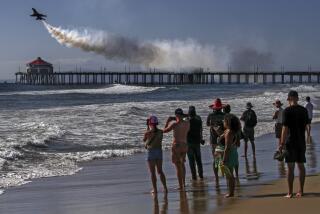Doubts Remain About Air Show’s Ability to Fly
- Share via
It will take far more than a wing and a prayer to transform Brown Field, a dusty and little-used former military airport, into a glamorous and exciting international air show and trade exposition.
Partly for that reason, some aviation and electronics industry observers doubt that Air/Space America will get off the ground May 13 for its planned nine-day run. The not-for-profit group organizing the show was formed two years ago by former Rep. Bob Wilson (R-San Diego).
An editor of one major aviation trade magazine last week acknowledged that his publication has “quite frankly viewed the whole thing with a lot of skepticism.”
Doubters express concern about the fact that Air/Space America has no track record. And they point to past attempts--including one by McGraw Hill in Orlando, Fla.--that failed. Even one strong supporter said last week that the San Diego show, in which about 300 exhibitors are expected to participate, is likely to have poor attendance by industry members.
Trade, Public Shows
The show will be divided into a five-day trade show for qualified members of the industry only and a four-day air show open to the public.
Most critics simply wonder if the industry needs yet another air show--even a U.S.-based show that is expected to highlight the nation’s aviation and electronics manufacturers. But Wilson maintains that the show will begin on schedule at Brown Field, in a remote corner of San Diego near the Mexican border.
So far, the organization has received $100,000 “Founders Club” donations from six major aerospace manufacturers--Hughes Aircraft, General Dynamics, Martin Marietta, Teledyne, Aerojet General and Ferranti International Signal, a British-owned company. San Diego-based Atlas Hotels also has contributed $100,000 and Wilson expects three more $100,000 donations to eventually surface.
A handful of other organizations, including Cubic Corp., San Diego-based SAIC and the Ryan Foundation each has donated $25,000 to Air/Space America. American Airlines has made a $25,000 contribution to become the show’s official airline.
Wilson is using that funding, along with revenue to be generated by weekend air shows that will be open to the public, to build a tent village on the southern edge of Brown Field. A veteran of 28 years in Congress, Wilson is now a consultant in Washington. He expects the trade show to draw 20,000 professionals daily, with the four weekend air shows drawing about 400,000 people.
On more typical days, Brown Field is mostly home to pilots who use its 8,000-foot main runway to practice touch-and-go landings. Navy parachutists use the airport as a staging point for practice jumps into rugged terrain just to the east. And an assortment of small aviation companies are clustered along the field’s southern edge.
Most of the action at Brown Field revolves around an aging control tower building that houses the Argus restaurant and bar.
At night, Border Patrol officers prowl the field’s perimeters in search of illegal aliens who pass the airport on their way north. The fact that the field is little used benefits the show’s chances of survival, according to Wilson, because Air/Space America will not interrupt any extensive commercial and private air traffic. And, the former military field’s durable runways will easily accommodate every type of aircraft now in service--including the Concorde, which is scheduled to appear during the weekend air shows.
Wilson is banking that the show will appeal to professionals at the thousands of aviation, aerospace and electronics companies on the West Coast--as well as appeal to Pacific Rim countries that are searching for new aerospace and electronics components.
But until recently, with less than two months to go, the only real evidence of the upcoming air show is a dusty, 140-acre tract near the field’s new control tower. There, a small group of construction workers was gradually scraping and grading the area that will host what Wilson envisions as a U.S.-based air show that one day will rival the grand Paris Air Show.
Last week, workers began erecting the first of four massive tents that will host as many as 300 aerospace and electronics exhibitors. Crews also are readying 22 “chalets,” tents that exhibiting corporations will use to wine and dine aerospace industry executives.
Nearly 80 members of the Palo Alto-based American Electronics Assn. had signed contracts to exhibit their wares during the trade show. The AEA has taken an “active role” in promoting the exposition and trade show among its members, according to AEA spokesman Chuck Jungi
Symposium by Magazine
And, Defense Science magazine, a Campbell, Calif.-based magazine with a circulation of 60,000, will conduct a symposium that will include the presentation of 72 wide-ranging professional papers.
Foreign buyers--including trade delegations from Italy, Costa Rica, Honduras, Argentina, Brazil, Japan, Saudi Arabia, Mexico, Great Britian and Canada--are expected to account for about 20% of the trade show attendance, according to Wilson.
The Soviet Union will exhibit three aircraft--the Su-26M aerobatic airplane, the Mi-34 sport aerobatic helicopter and the An-124 cargo transport airplane, the world’s largest flying aircraft.
Other countries, including Chile, Argentina, France and Sweden also will exhibit commercial aircraft.
But despite Air/Space America’s optimism, many aerospace industry observers still wonder if the show will succeed.
A major problem for Air/Space America is that significant major airframe manufacturers--including Boeing Aerospace, Lockheed Corp., and McDonnell Douglas Corp.--will not attend the air and trade show. Those companies prefer to concentrate their marketing efforts on the industry’s already established shows.
“Those companies just don’t think they make sales at these shows,” said one long-time industry observer. “They have their marketing programs in place, they know the customers and they damn well know when every plane has to be replaced.”
Wilson dismisses critics, arguing that the San Diego air show never expected to elicit strong support from commercial airframe manufacturers.
And, he dismissed as unfair the inevitable comparison that pits San Diego’s first-time show against the industry’s two best-known shows: the Paris Air Show that is staged during odd-numbered years at Le Bourget Field, and the Farnborough Air Show in Great Britain that is held in even-numbered years.
Air/Space America President Bill Walsh, a retired Navy admiral, believes the San Diego show will eventually evolve into a serious threat to the better-known shows. Both Wilson and Walsh believe companies that passed on Air/Space America during 1988 will have no choice but to exhibit when the second show rolls around in 1990.
Wilson said the show will draw at least 800 exhibitors during its third show in 1992. Show attendance, he said, will increase accordingly.
But both Wilson and Walsh acknowledge that Air/Space America has faced an uphill battle to survive and prosper. In the process, Wilson has had to scale back rather glitzy plan he unveiled in 1986.
Then, the former congressman announced a $25.3-million construction and operating budget that included an “$18-million complex of chalets, exhibitor facilities, shops and support outlets.”
Trimmed Budget
Air/Space America envisioned a semi-permanent complex that would transform a good portion of the dusty old military field that still includes several pre-World War II barracks buildings. But the organization trimmed that budget dramatically after potential exhibitors balked at investing in the first-time show.
Shortly after Wilson proposed the air show, spokesmen for several major aerospace companies complained that there were already too many air shows in existence. Those major manufacturers have, for the most part, continued their resistance to taking part in the new show.
Wilson acknowledged that the initial budget was unrealistic, and that many of the proposed improvements were not necessary. But he defends the current, $4-million budget as “adequate” to fund a first-class trade and air show.
But the organization is counting on two weekend air shows that will be open to the general public to generate about half of its revenue.
“There has been a lot of skepticism,” acknowledged Jim Martin, editor of Defense Electronics. “But they’ve been gathering momentum, and even though this show might be under-attended, it will be good.”
Turned to Colleagues
Wilson acknowledged that he has called upon former colleagues for support. “We’ve had to use congressional pressure and everything else” to keep the show moving ahead, Wilson said last week.
“And we’ve got a lot of connections that helped” persuade the Pentagon to allow the military to participate in the weekend air shows, Wilson said. Ultimately, the show’s success will be determined by how many buyers are in attendance. One industry observer suggested that Air/Space America will draw only about 7,000 professionals a day during the four-day trade show.
But another observer, who two years ago voiced doubts that the show would even take place, acknowledged that Air/Space America “could build itself a real strong foundation if it can establish itself as the show of the Pacific Rim.”
“That would force Lockheed and some of the other major companies to rethink their positions,” the observer said.
More to Read
Inside the business of entertainment
The Wide Shot brings you news, analysis and insights on everything from streaming wars to production — and what it all means for the future.
You may occasionally receive promotional content from the Los Angeles Times.










